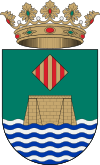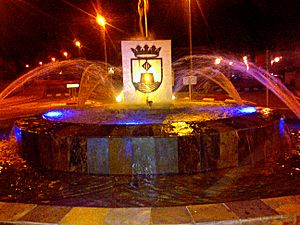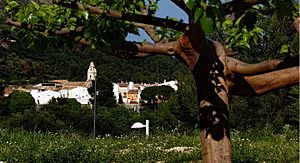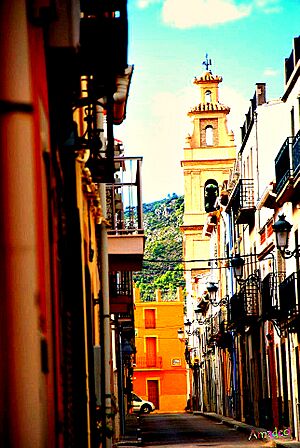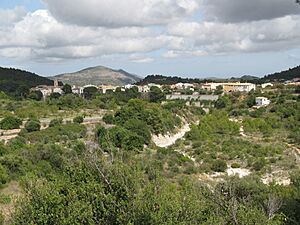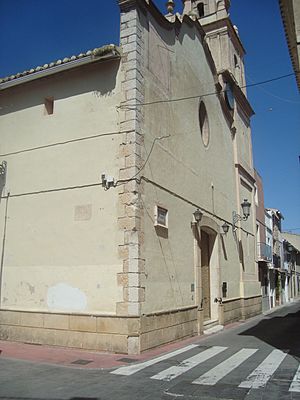Benigembla facts for kids
Quick facts for kids
Benigembla
|
||
|---|---|---|
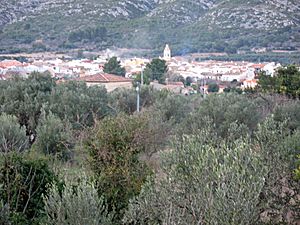
The town of Benigembla
|
||
|
||
| Country | ||
| Autonomous community | ||
| Province | Alicante | |
| Comarca | Marina Alta (comarca) | |
| Judicial district | Dénia | |
| Area | ||
| • Total | 18.40 km2 (7.10 sq mi) | |
| Elevation | 314 m (1,030 ft) | |
| Population
(2018)
|
||
| • Total | 444 | |
| • Density | 24.13/km2 (62.50/sq mi) | |
| Demonym(s) | Benigembler, benigemblera | |
| Time zone | UTC+1 (CET) | |
| • Summer (DST) | UTC+2 (CEST) | |
| Postal code |
03794
|
|
| Official language(s) | Valencian | |
| Website | [1] | |
Benigembla (Valencian pronunciation: [beniˈdʒembla]) is a small town in eastern Spain. It is located in a beautiful area called the Pop Valley, within the Marina Alta region. The town sits 314 meters (about 1,030 feet) above sea level. It is close to popular places like Benidorm (50 km away) and Valencia (105 km away).
Benigembla has a long history, going back to the time of the Moors. These were people from North Africa who lived in Spain many centuries ago. Near Benigembla, you can find ancient cave paintings at a place called Pla de Petracos. These paintings are over 8,000 years old! They are so important that UNESCO has made them a protected world heritage site. In 1609, many Moors from the Pop Valley had to leave their homes. Some tried to resist in a mountain called El Cavall Verd, but eventually, they had to give up. After this, people from Majorca and Catalonia moved to Benigembla. They brought their traditions and the Valencian language, which is still spoken today.
At the top of El Cavall Verd mountain, you can still see parts of an old castle called El Castell de Pop. This castle was once owned by a famous Moorish leader named Al-Azraq. Later, it was destroyed, and now only a few traces remain. The Pop Valley gets its name from this historic castle.
Contents
Who Lives in Benigembla?
Benigembla has seen many changes in its population over the years. In 1615, only 99 people lived there. The town grew to almost 900 people by 1860. However, from the 1900s to the 1960s, many locals moved away to places like the U.S., France, Germany, and Algeria.
Today, Benigembla is a very diverse town. According to a 2011 count, about 606 people lived there. In 2022, the population was 512. A large part of the population is from other countries. About 52% of the residents in 2022 were foreign. Most of these newcomers are British, making up about 67.5% of the foreign population. There are also people from North America, France, Germany, Belgium, Netherlands, and Eastern Europe.
The main language spoken by the local people is Catalan, also known as Valencian. Most residents speak and use it every day. This language and many traditions came with the settlers from Catalonia and the Balearic Islands after 1609.
| Changes in the population of Benigembla | |||||||||||||||||||
|---|---|---|---|---|---|---|---|---|---|---|---|---|---|---|---|---|---|---|---|
| Year | 1857 | 1887 | 1900 | 1910 | 1920 | 1930 | 1940 | 1950 | 1960 | 1970 | 1981 | 1991 | 2000 | 2006 | 2007 | 2009 | 2011 | 2022 | |
| Population | 809 | 879 | 758 | 667 | 649 | 730 | 693 | 689 | 564 | 549 | 420 | 380 | 392 | 563 | 570 | 589 | 606 | 512 | |
Festivals and Traditions
Benigembla celebrates two main festivals each year.
- In the third week of January, the town has its winter celebrations. These honor Sant Honorat and Sant Antoni. There is a fair, and people bring their pets and other animals to be blessed.
- During the summer, the biggest festival takes place from August 12th to August 17th. This summer party includes concerts, theater shows, and exciting fire runs called correfoc. There is also dancing, Valencian handball games, and even running with the bulls. Of course, there are religious celebrations too.
- In autumn, usually on the last weekend of October, there is a craft fair. Here you can find unique handmade items.
Nature and Scenery
Benigembla is located in the Pop Valley, next to the River Gorgos. It is surrounded by mountains, making it a great place for outdoor activities. The area covers 18.4 square kilometers (about 7 square miles). You can enjoy climbing mountains like El Cocoll or El Cavall Verd. El Cavall Verd is a unique mountain that looks like a woman's face!
The town is well-known for its many walking trails and amazing mountain views. The highest mountain peak in Benigembla is El Morro d'en Serra, which is 1,001 meters (about 3,284 feet) high. Another interesting walking trail is "The Route of El Mirabó". Other important mountains nearby include La Penya de l'Altar (949 m) and La Solana (793 m).
A special plant called Caralluma mumbyana grows on El Cavall Verd mountain. This is a rare type of cactus with bright pink flowers. It is found only in southeastern Spain and is in danger of disappearing. There are only three other known groups of this plant in the Valencian Country. The IUCN protects it. The Xaló-Gorgos river flows next to Benigembla. The European Commission named it a site of special community interest in 2005. This river is 55 km (about 34 miles) long and flows into the sea at Xàbia.
Economy and Fun Things to Do
For a long time, farming and raising animals were the main ways people made a living in Benigembla. But since the 1970s, most people work in services, like shops or tourism. Farming is now more of a hobby for weekends and holidays. Still, farmers in Benigembla produce wine, olive oil, almonds, figs, olives, and grapes.
The town has two restaurants and two rural houses where visitors can stay. There is also a fun recreational area called The Safareig, which has barbecue spots. A camping area is located just 1 km (about half a mile) from Benigembla, on the road to Castell de Castells. This camping site has a swimming pool, a tennis court, and other facilities.
Another interesting place is The Ribàs Botanical Garden, right next to the main square. It has trees that are over 100 years old and many other special plants. This park was recently updated in 2022 and is a great example of Mediterranean plant life in the Marina Alta region.
Benigembla is also famous for its street art, or graffiti. It has a "Living Museum" where art comes to life on the streets. Every year, in late spring or early summer, a festival brings graffiti artists from all over the world to Benigembla. They paint beautiful and colorful murals on the buildings. This festival started in 2018 and attracts many visitors who come to see the amazing artwork.
Some outdoor scenes for the film "Her Majesty the Minor" were filmed in Benigembla in 2006. This was a big European movie directed by Jean-Jacques Annaud, who also directed famous films like "Seven Years in Tibet" and "The Name of the Rose".
Historic Buildings and Places
Benigembla has several interesting old buildings and sites:
- The Parish Church of "Saint Josep": This church was built in the 18th century in a neoclassical style. It has a beautiful baroque bell tower. The church was restored in 1994.
- "El Safareig": This used to be the town's public laundry area. Today, it is a recreational spot with a barbecue area.
- The "El Sindicat" Building: This building has neoclassical elements with French baroque and rococo styles. It was built in 1925 and used to be a social club. The Town Council bought it in 2005 and renovated it. Now it has three floors and is used for exhibitions, conferences, classes, and even dancing.
- The Bridges: The bridges on the road to Parcent and Murla were built by skilled stonemasons.
- "El Ribàs" Walls: These strong walls protect the western part of the town from floods from the "Xaló-Gorgos" river. They were built by stonemasons after a big flood in 1890. The main square of the town is named after Mr. Baldomero Vega de Seoane, who helped get the money for these walls.
- "Els Riuraus": These are special buildings typical of Benigembla. They were used to dry grapes, keeping them safe from rain.
See also
 In Spanish: Benichembla para niños
In Spanish: Benichembla para niños


